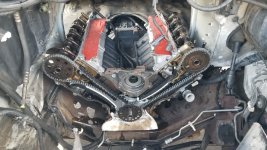Gregger
Living Legend
I totally agree with this. Remember, the heavy main positive and negative wires going to the starter have no fuse or circuit protection. When they are activated, it's like running a positive and negative wire from the battery directly to the starter. The power from the relay to the solenoid pull in winding keeps it going. Only the control side or the starter circuit including the relay, push button, starter solenoid pull in windings etc have fused protection. I agree with @Mongler07 and @TURBO200R4 stating that the solenoid washer probably stuck to the contacts or some other solenoid part stuck, causing current to flow directly to the starter from the battery regardless of the control side being powered. Pulling the fuses with a stuck solenoid would do nothing since current would continue to flow. Regarding pulling the 30 amp fuse causing the starter to slow down??? That's kind of a mystery. You would think it would have caused the starter to speed up since you basically shut off current flow to all other circuits allowing more voltage to the starter.more than likely the solenoid washer stuck against the contacts or just welded to the contacts.
hth
I'm curious, did you notice if the lights went off when you pushed the starter button, then come back on after releasing the button when the starter continued to spin uncontrollably??? If the lights actually did come on when you released the button, it kind of signals that the control circuit and relay were working properly reinforcing the stuck solenoid diagnosis.
As a side note, I can remember in the 70's in Northern Ontario the problems we had with GM vehicles in very cold weather whereby starter motors would continue cranking with no way to shut them off. I had a stick which I would hit the starter solenoid which usually stopped the starter. We determined that the solenoids were frosting up and sticking. Caused a lot of problems with GM owners.
Last edited:

